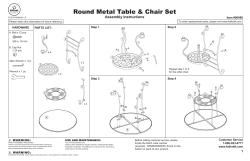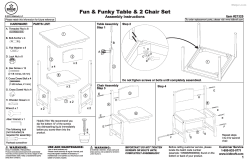
Static Analysis, Dynamic Analysis and How to Use Them Together ROOTS 2008
Static Analysis, Dynamic Analysis
and How to Use Them Together
ROOTS 2008
April 29th, 2008
Dan Cornell – dan@denimgroup.com
Agenda
•
•
What is Application Security?
Dynamic Analysis
– Definition
– Types of Defects Detected
– Tool Examples
•
Static Analysis
– Definition
– Types of Defects Detected
– Tool Examples
•
Using Them Together
– Which to Use: Strengths and Weaknesses
– Process Implications
•
Questions
Denim Group Overview
•
•
Boutique IT consultancy
Two sides of business:
– Software Development
• .NET
• JEE
– Software Security
•
•
•
•
•
Assessments and Penetration Tests
Code Reviews
Training
SDLC Consulting
C
lti
Consultants rotate between project types
3
What is Application Security?
•
•
•
•
Ensuring that applications behave as expected under the entire
range of possible inputs
Confidentiality, Integrity, Availability
y a subset of software correctness/quality
q
y assurance –
Really
however…
More typically focused on what an application is NOT supposed
to do rather than what it IS supposed
pp
to do
Software Implementation – Perfect World
Actual
Functionality
IIntended
t d d
Functionality
5
Software Implementation – Real World
Actual
A
t l
Functionality
IIntended
t d d
Functionality
Built
Bugs
Features
Unintended
And Undocumented
y
Functionality
6
Brief Demonstration
•
•
RiskE Utility – an intentionally flawed public utility website
See the application from the standpoint of an attacker
Why is Application Security
p
Important?
•
Critical software systems are increasingly exposed to hostile
traffic
– Internet, Extranet, Intranet
•
Software systems are not being built in a secure manner
– Security is not part of the traditional Computer Science curriculum
– @Stake
@S k and
d Foundstone
F
d
studies:
di
2/3 off application
li i are vulnerable
l
bl
•
Governments and other regulators have stepped in
– HIPAA, SOX, CA SB-1386 in the US
– PCI iin th
the US ((coming
i soon tto a C
Continent
ti
t near you…))
•
There was no “software security” tribe mentioned in yesterday’s
talk
A Quick Note
•
Addressing the software security issue must be done by
educating developers and improving the software development
process
•
•
•
Today we will be talking about tools.
Tools are an important PART of the solution.
Tools alone are NOT the solution.
How Not To Do It
•
•
•
•
•
•
•
•
Q: What are you all doing to address application security
concerns in your organization?
A: We bought “XYZ Scanner”
Q: Okay… Are you actually using it?
A: We ran some scans
Q: And how did that go?
A: Oh we found some stuff…
Q: How did you address those issues?
A: I think we sent the report to the developers. Not sure what
they did with them. I guess I ought to check in on that…
10
General Limitations of Automated
Tools
•
•
•
There are defects they can find and defects they cannot find
Passing automated tests cleanly does not mean the application
is “secure”
Approximately 50% of defects cannot be found by automated
tools (Dr. Gary McGraw)
– Authentication and authorization issues
– Business logic flaws
•
Tools are a great means to “baseline” application security
What Is Dynamic Analysis?
•
Examining running software to see how it behaves under
different stimuli
– Analyzing request and response patterns
– Checking remotely-detectable configuration settings
•
•
Analyzing software “in motion”
Also called “application assessment” or “application penetration
testing”
•
PLEASE NOTE: Unless otherwise discussed, Dynamic Analysis
will refer to Dynamic Analysis being performed by an automated
tool
General Approach
General Approach
•
“Spider” the application to enumerate potential attack endpoints
– Web pages (URLs), FORMs, parameters
•
•
Run tests against the application
Compile results
Types of Defects Detected
•
•
•
•
Server Configuration
“Known Bad” Software
Configuration Management
Input Handling
Server Configuration Defects
•
•
•
TRACE HTTP methods enabled
DEBUG enabled
Insufficient patches
“Known Bad” Software
•
•
Request well-known URLs and check the response for text
identifying known-bad files
This will find well-known software packages with identified
defects
– CVE-type stuff
•
This is where application security scanners most overlap with
tools such as Nessus, ISS, Qualys, etc
Configuration Management
Defects
•
Based on the file and directory structure, look for suspicious files
– File.aspx -> File.aspx.bak, “Copy of File.aspx” and so on
•
•
Backup files
Exposed log files
Input Handling Issues
•
Send in suspicious inputs, look for error messages in the results
•
SQL Injection: Send in ‘, “ and other SQL control
characters, look for error messages including
“SQL”, “ODBC”, “JDBC” and so on
•
Cross Site Scripting: Send in HTML such as <ABC123 and look
for that HTML returned to the browser unescaped
p
•
Can also be used to find Command Injection, LDAP Injection
and so on
Examples of Dynamic Analysis
Tools
•
Paros
Paros
• Java-based web proxy
• Similar to WebScarab
• Also does some
automated testing
paroxproxy.org
Limitations of Dynamic Analysis
•
It is hard to determine the attack surface
– Web application URL structures can be complicated
– REST-style naming conventions – what are endpoints?
– Spider routines can fail to find all URLs and endpoints or can get bound up
re-examining pages
•
•
•
The tool only has access to contents of requests and responses
False positives can be time consuming to address
Solutions?
– M
Mostt tools
t l have
h
manuall crawll modes
d tto d
deall with
ith iissues with
ith spidering
id i
algorithms
– Most tools also have proxies that can be used to manually augment
automated results
What is Static Analysis?
•
Analyzing software artifacts in order to gain information about
the software
– Source code
– Binaries
– Configuration files
•
•
Analyzing
Anal
ing software
soft are “at rest”
Also called “white box testing” and “source code review”
•
PLEASE NOTE: Unless otherwise discussed, Static Analysis
will refer to Static Analysis being performed by an automated
tool
Overview
•
•
General Approach
Source or Binary?
General Approach
General Approach
•
•
•
Pre-process the application artifacts into some internal
representations
Run tests against the application
Compile results
Source or Binary?
•
•
Access to source typically provides more information to the
analysis tool than only having access to the binaries
Advantages of binaries:
– More commonly available
– If you dynamically generate binaries based on database schema, etc
Source or Binary – C/C++
•
•
“Vanilla” C can be reasonably easy to decompile, but…
C++ and C compiled with compiler optimizations can be
challenging to decompile sensibly
Source or Binary – Java or .NET
•
These environments are pretty easy to decompile
– “Source” recovery is typically pretty easy
•
Most .NET tools actually use binaries and disassemble them
into IL
– Thus they only have to have one parser to process IL rather than one for
every .NET
NET language
Different Approaches
•
•
Increasing the scope of analysis increases the capability of the
tool to find potential errors
As scope increases, tools must either effectively prioritize
analysis options or risk having excessive runtimes
Scope and Capability
Scope of Analysis versus Capability of Tool
5
4
3
2
1
0
Line
Function
Module
Program
System
Line Focus
•
•
•
Like using “grep” to identify banned or suspect function calls
This was the approach taken by early tools
Good way to make a quick pass for potential vulnerabilities
– Good for targeting manual review
•
•
Challenging
g g to use on large
g codebases
The more “signatures” that are included, the higher the noise to
signal ratio will be
– Just looking
g for specific
p
functions
Line Focus Example
•
Rule: gets() is BAD
• Input:
my_str = gets();
•
Result: Flag this line for review
•
P tt basic,
Pretty
b i but
b t better
b tt th
than nothing
thi
Line Focus: C/C++
•
Known “bad” APIs:
–
–
–
–
strcpy()
gets()
scanf()
sprintf()
Line Focus: Java
•
SQL injection
– [Connection].createStatement()
•
XSS
– <%=
•
More general parameter tampering:
–
–
–
–
[HttpServletRequest].getParameter()
[HttpServletRequest].getParameterValue()
[HttpServletRequest].getCookies()
[HttpServletRequest] getHeader()
[HttpServletRequest].getHeader()
Line Focus: .NET
•
SQL Injection:
– SqlCommand
•
XSS
– <%=
•
More general parameter tampering
– Request[
– Request.Cookies[
– Request.Headers[
Two (Crappy) Scripts I Wrote
•
•
dotnetcheck.sh and javacheck.sh
Implement the checks I mentioned above
Function and Module Focus
•
At this point the tool needs to be acting as a compiler
– Parse into tokens, determine lexical structure
•
This allows for much more sophisticated analysis
– State machines
– Control flow
– Data
D t flow
fl
Function and Module Focus
p
Example
•
Rule: Memory should only be freed once
•
Input:
void f()
{
my_mem = malloc(256);
ll (256)
free(my_mem);
free(my_mem);
}
•
Result:
– my_mem is marked as allocated
– my_mem is marked as freed
– Flag the second call to free(my_mem) as an issue
Program and System Focus
•
•
Expanding the scope of inquiry allow tools to find more and
more subtle flaws
Also helps avoid false positives
Dataflow and Taint Tracking
•
Track dataflows through the system
– Sources and Sinks
•
Attach taint flags to inputs
–
–
–
–
–
•
What type of taint?
–
–
–
–
•
Web parameters and cookies
Data read from files
Environment variables
Data read from databases
Data read from web services
From the network
From a configuration setting
From a database
And so on
Identify “cleaning” functions
Taint Sources and Sinks for a
pp
Web Application
Taint Sources and Sinks for an
y
SUID Root Binary
Program and System Focus
p
Example
•
Rule:
– User-supplied data should never be included in a SQL query without being
properly
l escaped
d
Program and System Focus
p (continued)
(
)
Example
•
Input:
public void doGet(HttpServletReqest req, HttpServlet Response resp)
{
String user = req.getParameter(“username”);
logStuff(user, “my_page”);
//
Render out HTML…
}
private logStuff(String user, String location)
{
Connection con = getConnection();
Statement stmt = con.createStatement();
con createStatement();
String sql
= “INSERT INTO log (user, location) VALUES (‘” + user + “’, ‘” + location + “’”
stmt.executeUpdate(sql);
}
Program and System Focus
p (continued)
(
)
Example
•
Result:
– Input from getParameter() call is marks user variable as tained (Source)
– Flow of data is traced into the logStuff() method
– sql variable is also marked as tainted when it is concatenated with
username parameter
– executeUpdate() is marked as a security issue because it received tainted
data (Sink)
Examples of Static Analysis Tools
•
•
•
•
FindBugs (Java)
PMD (Java)
FxCop (.NET)
XSSDetect (.NET)
FindBugs (Java)
•
•
•
•
Java-based static analysis tool
LGPL-licensed
Originally developed by Dr. Bill
Pugh from the University of
Maryland
Intended to find correctness
issues, also identifies some
security issues
findbugs.sourceforge.net
PMD (Java)
•
•
•
Java-based static analysis tool
BSD-licensed
Lead developers are David DixonPeugh and Tom Copeland
• Intended to find correctness and
complexity issues, also finds some
security issues
p
pmd.sourceforge.net
g
FxCop (.NET)
• Microsoft-provided tool for .NET static analysis
• Freely available
• Enforces coding standards (variable naming, etc)
• Similar to FindBugs in its security capabilities
www gotdotnet com/Team/FxCop/
www.gotdotnet.com/Team/FxCop/
XSSDetect (.NET)
•
•
•
Microsoft-provided tool for .NET static analysis
Freely available (BETA!)
Performs data flow analysis to identify Cross Site Scripting
(XSS) defects
blogs.msdn.com/ace_team/archive/2007/10/22/xssdetect-public-beta-now-available.aspx
•
Based on the Microsoft Research Phoenix framework
– For software analysis and optimization
– research.microsoft.com/phoenix/
Limitations of Static Analysis
•
Code is not the only software artifact that has security
implications
– Configuration files like web.xml, web.config
– Declarative programming
•
•
Volume of results and false positives can be time consuming to
address
dd
Solutions?
– Custom rules can help to add some application specific context
Which to Use?
•
Static Analysis
– Advantages
– Disadvantages
•
Dynamic Analysis
– Advantages
– Disadvantages
Di d
t
•
Actually Making a Decision
Static Analysis Advantages
•
Have access to the actual instructions the software will be
executing
– No need to guess or interpret behavior
– Full access to all of the software’s possible behaviors
Static Analysis Disadvantages
•
Require access to source code or at least binary code
– Typically need access to enough software artifacts to execute a build
•
•
Typically require proficiency running software builds
Will not find issues related to operational deployment
environments
Dynamic Analysis Advantages
•
•
•
Only requires a running system to perform a test
No requirement to have access to source code or binary code
No need to understand how to write software or execute builds
– Tools tend to be more “fire and forget”
•
Tests a specific,
p
, operational
p
deployment
p y
– Can find infrastructure, configuration and patch errors that Static Analysis
tools will miss
Dynamic Analysis Disadvantages
•
Limited scope of what can be found
– Application must be footprinted to find the test area
– That can cause areas to be missed
– You can only test what you have found
•
No access to actual instructions being executed
– Tool
T l is
i exercising
i i th
the application
li ti
– Pattern matching on requests and responses
Dynamic, Static and Manual Testing
Actually Making a Decision
•
No access to source or binaries? Dynamic
•
Not a software developer, don’t understand software builds?
Dynamic
•
Performing a “penetration test” or other test of an operational
environment? Dynamic
•
None of the previous problems? Static
•
R ll wantt tto d
Really
do th
the jjob
b right?
i ht? Both
B th ((and
d then
th some…))
Actually Making a Decision
•
•
In our experience:
Information Security practitioners are more comfortable with
the Dynamic Analysis tools
– Analog to scanners such as Nessus, Qualys and ISS
•
Software Development practitioners are comfortable with both
Static and Dynamic Analysis tools, but can get the most value
out of Static Analysis tools
– More complete view of the software
– Integration
I t
ti with
ith IDEs
IDE is
i a plus
l
•
Understand that there are things that tools can find, and things
tools can’t find. Running a tool doesn’t make you “secure”
Process Implications
•
•
Automated tools can provide tremendous security benefits if
used properly
It is easier to start a new project using a tool than to impose one
on an existing system
Development Implications
•
I have found that using a Static Analysis tool while developing
helps to improve my coding skills
– Immediate feedback when mistakes are made
– Learn more about language and platform internals
Process Implications: Questions
•
•
•
Who is going to run the tool?
When is the tool going to be run?
What will be done with the results?
•
Until you can answer these questions
questions, you should not assume
that a automated security testing tools will help you improve
security
General Best Practices
•
Static Analysis and Dynamic Analysis tools are complimentary
– Some overlap in capabilities
– Some things that neither class of tools cover
Dynamic, Static and Manual Testing
General Best Practices
•
Static Analysis
– Use during development to “baseline” code quality and security
(D
(Development
l
tT
Team))
– Use as a gate criteria for deploying applications (Security Team, QA Team)
•
Dynamic Analysis
– Use during and after deployment to examine live environments (Security
Team)
– Use during development to identify any configuration and potential
deployment issues (Development Team)
Additional Resources
•
Open Web Application Security Project (OWASP)
– www.owasp.org
•
•
Book: Secure Programming With Static Analysis (Brian Chess
and Jacob West)
Blog: Microsoft Code Analysis and Code Metrics Team Blog
– blogs.msdn.com/fxcop/
•
Website: FindBugs publications page
– findbugs.sourceforge.net/publications.html
•
Various commercial vendors…
Questions
Dan Cornell
dan@denimgroup.com
+1 210 572 4400
Website: www.denimgroup.com
Blog: denimgroup.typepad.com
© Copyright 2025





















